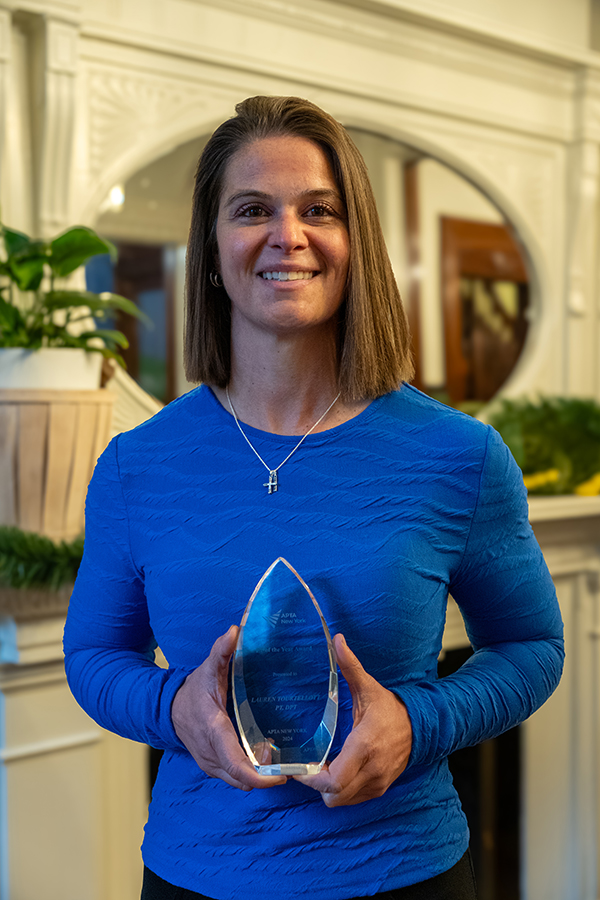
Lauren Tourtellott, DPT, a physical therapist with board certification in neurology and an assistant professor in Russell Sage College’s Doctor of Physical Therapy degree program, was named PT of the Year by the New York chapter of the American Physical Therapy Association.
She’s also a high school soccer coach and former Division I student-athlete who sees parallels between her roles with patients, students, and athletes. She talks about these parallels and more in the following Q&A.
Congratulations on being named PT of the Year! The writeup in the APTA NY newsletter acknowledged your dedication to excellence, compassionate patient care, and commitment to advancing the profession. Tell me more about the work that helped you stand out for the award.
I was nominated by a colleague in my department, Rupali Singh. The letter she wrote had to do with my role as an educator and in the patient world as well.
I teach in our DPT program’s neuro track, and I’m the associate director of clinical education.
I also work in inpatient rehab. I am a Neurologic Certified Specialist. I treat all patients, but I work with neuro patients most often. So, anybody who has a traumatic brain injury, stroke, spinal cord injury, MS, Parkinson’s, the whole spectrum of neuro.
Is there something specific that inspired you to pursue the Neurologic Specialist certification?
I decided I wanted to be a physical therapist when I was a soccer player. I hurt my knee and went to PT, and I was like, “Oh, this is neat!”
Then when I was in college, my grandfather was diagnosed with a benign brain tumor. He had an operation, and he ended up with a traumatic brain injury. He went to inpatient rehab, and what I saw from the moment he went in to watching him walk out of that facility really changed things for me. I went from thinking that I wanted to work with young athletes to wanting to work with people who had more complex injuries.
His physical therapist, Kerri Maloney, who I now know well, inspired me to go into the field. When I received the award, she’s one of the people I reached out to, and I reiterated how she changed my career track and inspired me to want to move into neuro.
What attracted you to your teaching role?
I’m also a high school soccer coach; I really enjoy coaching and teaching is no different except my voice is a little bit lower in the classroom than it is out on the field!
In 2019, Sage was going through an accreditation process and looking for outside clinicians to review the DPT program. I was asked, because of my board certification, if I would look at the neuro track.
I met the then-chair who’s now my colleague, Jim Brennan. He later reached out to see if I’d be interested in teaching a lab. I decided to give it a shot and I progressed from there. They asked me to teach a course and then, when the full-time position came up, I applied and got it.
I teach Patient/Client Management: Adult Neuromuscular System and Neuropathology. I also teach a first-year course called Foundations of Physical Therapist Clinical Examinations. Students take a lot of foundational courses in science; this is their first opportunity to actually see what the profession does. I’ve enjoyed it very much.
Then I’m associate director of clinical education, which entails working with the director Jennifer Aiossa to administer the clinical placements. Together as a team we work to support students’ success as they transition from the classroom to clinical work.
Do you have a favorite class to teach or a favorite part of your role?
The first lecture course that I ever taught as an adjunct is my neuropathology class, and it’s still my favorite class to teach. Because I have a lot of clinical experience, I can teach it from the clinical aspects, which I think students appreciate.
My favorite part of my job is working directly with students and watching them reach their full potential. I feel that the most important role of an educator or coach is to build self-efficacy. I take that responsibility seriously by challenging them and pumping them up.
Please say more about how you use your clinical experience in your classroom, and vice versa.
The biggest thing that I bring from my clinical role into the classroom is really being able to relate real-life examples. When we’re talking about something, I can give an example.
There’s tons of different types of strokes, and they all present very differently. I’m able to give multiple examples of different ways things could be managed from my experience with several different diagnoses. There’s very few diagnoses that I teach that I say, “This is what I’ve read in the book. I’ve actually never seen this before.” Most things I teach, I can give multiple examples of things you’re going to see with the patient or different challenges they may face.
And being in the academic world definitely helps me as a clinician. I have to be sharp on anatomy, the central nervous system, the peripheral nervous system, because I have to teach it. And because I have to explain it to students, I’m also better at explaining it to patients when they ask,”What does a stroke mean here?” or “What does it mean if there’s an MS lesion here?”
What are you looking forward to during the spring 2025 semester?
I’m really looking forward to rolling out year two of my Patient/Client Management: Adult Neuromuscular System course. Patient/Client Management courses are my biggest responsibility. I teach the lecture and also manage the lab and lab faculty. I’m continuing to evolve this course, based on evidence-based practices coming out of the Academy of Neurological Physical Therapy.
Like I said, it’s year two, so I’m expecting it to be better than last year, and of course not as good as it’ll be next year, because I always strive to improve. I have new lab faculty, and I’m looking forward to supporting my team, just like I try to do with my soccer staff. I’m looking forward to working together to give students a great experience and hopefully inspiring some of them to want to be neuro PTs, just like I was inspired myself.
I’m also working with a couple of students in our second-year cohort on a research project that I’ve been interested in for a while and that will be part of their capstone. We are looking at clinical differences between individuals diagnosed with Parkinson’s disease and atypical Parkinsonian disorders in the hopes of advancing a potentially earlier and less invasive way to diagnose atypical Parkinsonism.
And I’m continuing to work with Rupali Singh who is leading research on the effects of laser therapy on painful diabetic peripheral neuropathy.
Before we wrap up, I want to ask about your work as a coach.
I’m the varsity girls soccer coach at Averill Park High School. We are the “little guys” and smallest school in the Suburban Council but we show up to match all the big schools. I have a fantastic coaching staff that I very much enjoy working and spending time with. No matter what their future holds whether they become career coaches or this experience is just their stepping stone to their next future endeavor my hope is this experience being part of this team gives them the skill set they need be successful in the future.
Is there anything you’d like to add?
I’m a student myself! I’m finishing my Doctor of Health Science degree. I have one more semester of courses, and I will start my dissertation proposal this summer.
I haven’t narrowed it down yet, but I want to do something in education research. I want to determine what we can do as educators to help students combat day-to-day stress or test anxiety, because ultimately, as I tell my students, patients are test questions that come with no answers. It is important going into the big game whether it be in sports or taking an exam with the right mindset.

